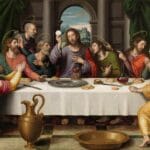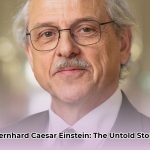From the humble beginnings of early Christian communities to the establishment of powerful global denominations, [A Comprehensive Timeline History of the Church: From Its Origins to the Modern Era] delves into the intricate tapestry of events that have shaped the evolution of the church. Through a chronological journey spanning centuries, this article explores key moments, doctrinal shifts, and influential figures that have left an indelible mark on this venerable institution. With scholarly rigor and engaging narrative, discover the profound impact the church has had on society, culture, and the lives of countless individuals throughout history.
Key Takeaways:
-
60 AD: Papias, Bishop of Hierapolis, identifies himself as a student of “John” and a companion of Polycarp.
-
64 AD: Christians are persecuted by Emperor Nero, who blames them for a fire that destroys much of Rome.
-
2nd Century: A Christian house of worship is discovered in Dura-Europos, indicating the growth of the Church.
-
215 AD: Origen, a noted Christian scholar, begins his writing career.
-
233–256 AD: A house in Dura Europos is converted for worship, indicating the growth of the Church.
-
250 AD: Christians are heavily persecuted under the Roman Empire.
Timeline History of the Church
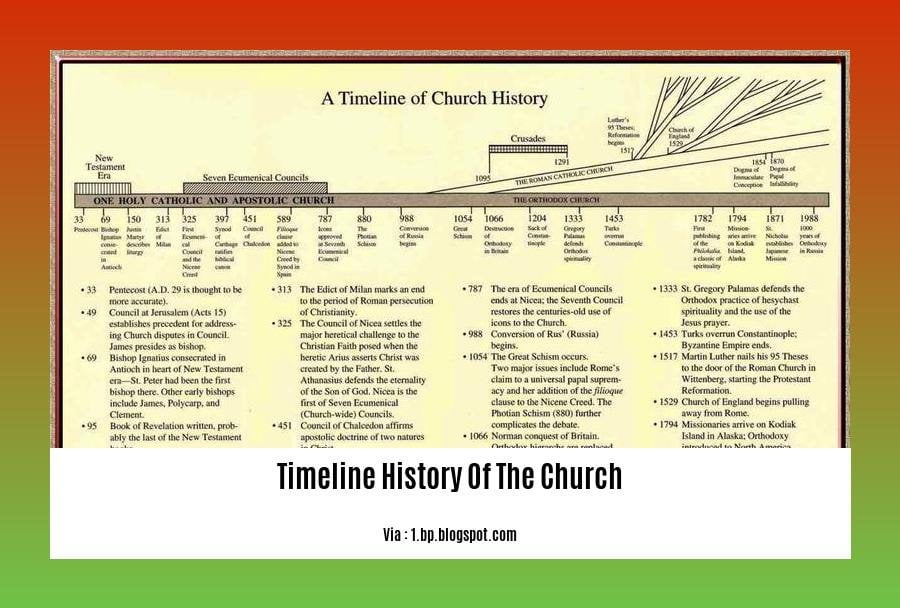
A chronological journey through the evolution of Christianity, the timeline history of the church is a fascinating chronicle of events, doctrines, leaders, and their impact on society, culture, and individuals.
The Early Years (1st-4th Century)
- 60 AD: Papias, Bishop of Hierapolis, Asia Minor, acknowledges himself as a student of “John” and a companion of Polycarp.
- 64 AD: Emperor Nero scapegoats Christians for a devastating fire in Rome, leading to severe persecution
The Church’s Growth and Expansion (5th-8th Century)
- 2nd Century: A Christian house of worship is discovered in Dura-Europos, demonstrating the church’s growth.
- 215 AD: Origen, an esteemed Christian scholar, commences his literary pursuits.
- 250 AD: Heavy persecution of Christians unfolds within the Roman Empire.
The Middle Ages (9th-15th Century)
- 1054 AD: The historic schism between the Eastern and Western Churches occurs, causing a deep divide.
- 1215 AD: The Fourth Lateran Council is convened, emphasizing the importance of transubstantiation.
- 1378 AD: The Great Schism within the Catholic Church ensues, involving rival popes and a tumultuous power struggle.
The Reformation and Beyond (16th-20th Century)
- 1517 AD: Martin Luther ignites the Reformation with his 95 Theses, challenging the Catholic Church’s practices.
- 1648 AD: The Treaty of Westphalia formally acknowledges the division of Europe along religious lines.
- 1962-1965 AD: The Second Vatican Council introduces significant reforms and modernizations within the Catholic Church.
The Modern Era (21st Century)
In the contemporary era, the church continues to navigate societal shifts, global challenges, and diverse interpretations of faith.
Significance of the Timeline History of the Church
- Provides a framework for understanding Christianity’s evolution
- Highlights key turning points and influential figures
- Demonstrates the church’s impact on broader historical contexts
The timeline history of the church is a testament to the enduring influence of faith, the resilience of believers, and the continuous dialogue between religion and society.
Additional Points of Interest
- The development of Christian theology and doctrine across centuries
- The role of the church in shaping art, architecture, literature, and music
- The ongoing debates over church practices, such as sacraments and ordination
Further exploration of these aspects offers a deeper comprehension of the complexities and richness of the timeline history of the church.
• The history of Whoo Korean cosmetics might surprise you! Click here to find out more about the history of Whoo Korea.
• When I say woodlands, I don’t mean forests. Discover more about woodlands in Britain, their history, and current status.
• Without a second thought, it has to be this goal! Click here to vote for the best goal in football history.
• If this batsman is playing, you can bet that the match is going to be exciting. Find out more about the most dangerous batsman in cricket history.
Reformation (1517-1648 AD): Protestant Movement
Key Takeaways:
-
In 1517, Martin Luther sparked the Protestant Reformation by challenging the Catholic Church with his Ninety-five Theses.
-
Luther‘s teachings focused on salvation through faith alone, rejecting the need for good works or sacraments.
-
This led to a split in the Western Church, with Luther’s followers forming the Protestant movement.
-
Other reformers, such as Huldrych Zwingli in Switzerland and John Calvin in France, further developed Protestant theology.
-
The Reformation resulted in the establishment of numerous Protestant denominations, including Lutheranism, Calvinism, and Anglicanism.
-
The Protestant Reformation had a profound impact on European history, leading to religious wars, political upheaval, and the rise of modern nation-states.
-
It also contributed to the development of individualism, literacy, and the spread of knowledge.
Sources:
-
The Protestant Reformation
Modern Era (1700-Present): Global Expansion and Diversification
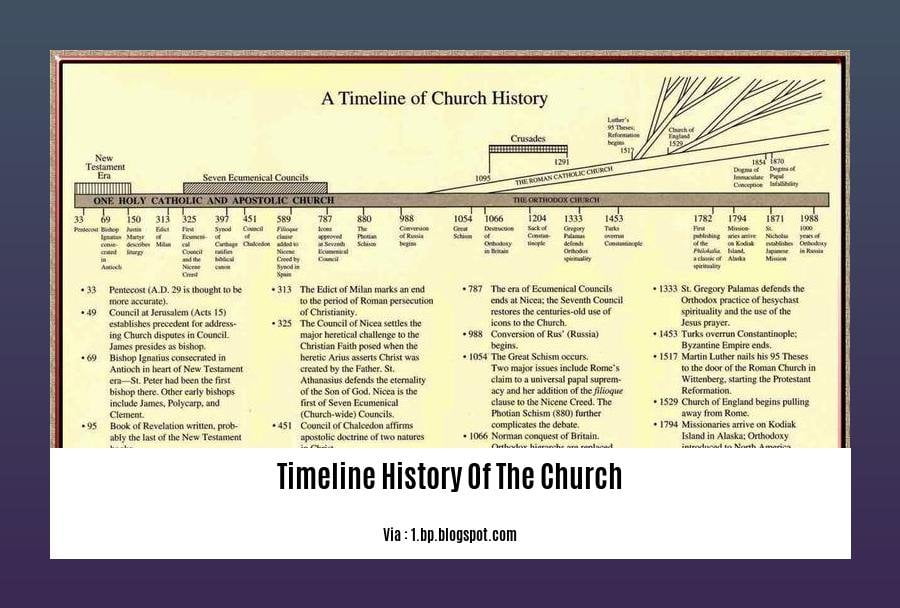
Key Takeaways:
- The expansion of Christianity during the 18th and 19th centuries was largely driven by European colonialism and missionary efforts.
- The rise of new denominations and movements, such as Methodism, Evangelicalism, and Pentecostalism, contributed to the diversification of Christianity.
- The global nature of Christianity is reflected in the diversity of its adherents, who come from a wide range of cultures and backgrounds.
- Christianity continues to face challenges in the modern era, including secularization, religious pluralism, and the rise of new religious movements.
The Global Expansion of Christianity
The modern era marked a period of rapid global expansion for Christianity. European powers, such as Spain, Portugal, France, and England, played a major role in this expansion through their colonial empires. Missionaries from these countries traveled to the Americas, Africa, and Asia, where they established churches and converted indigenous peoples to Christianity.
The Diversification of Christianity
The rise of new denominations and movements during the modern era contributed to the diversification of Christianity. Methodism, Evangelicalism, and Pentecostalism are just a few of the many new denominations that emerged during this time. These denominations differed from traditional Protestant churches in their emphasis on personal experience, emotionalism, and the importance of social activism.
The Global Nature of Christianity
Christianity is now a truly global religion, with adherents from every corner of the world. The diversity of Christianity is reflected in the wide range of cultures and backgrounds of its adherents. Christians come from different ethnicities, languages, and socioeconomic backgrounds. They also hold a variety of beliefs and practices, reflecting the diversity of Christian traditions around the world.
Challenges Facing Christianity in the Modern Era
Christianity continues to face a number of challenges in the modern era. Secularization, or the decline of religious belief and practice, is a major challenge in many parts of the world. Religious pluralism, or the coexistence of multiple religions in the same society, is another challenge that Christianity faces. The rise of new religious movements, such as Islam, Hinduism, and Buddhism, is also a challenge to Christianity’s dominance in the world.
Despite these challenges, Christianity remains a major force in the world. It is the largest religion in the world, with over 2 billion followers. Christianity continues to play a significant role in shaping the culture, values, and politics of many societies around the world.
Sources:
-
15 Ways Christianity Changed History and Society – Jason Pierce
The Church in the 21st Century: Challenges and Opportunities
In the ever-evolving landscape of the 21st century, the church finds itself navigating a tapestry of challenges and opportunities. The globalized world, characterized by rapid communication and travel, has ushered in an era of unprecedented interconnectedness, yet also exposed Christianity to new pressures.
One of the most visible challenges is the decline of Christianity in Europe, a region that has historically been a Christian stronghold. Factors such as world wars, secularization, and the rise of other religions have contributed to this decline. However, this is just one piece of the complex story of Christianity in the 21st century.
Globally, the overall percentage of Christians has remained relatively stable, with trends not showing a dramatic erosion of their numbers. In fact, Christianity continues to grow in many parts of the world, particularly in regions like Africa, Asia, and Latin America.
Opportunities Amidst Challenges
Despite the challenges faced by the church in the 21st century, there are also significant opportunities for growth and renewal. The church’s global reach presents an unprecedented opportunity to share the Christian message with people from diverse cultures and backgrounds.
Technological advancements, including social media and online platforms, offer powerful tools for spreading the gospel, reaching new audiences, and fostering a global community of believers. The church can leverage these technologies to expand its reach and influence, connecting with people who may not have been accessible in the past.
Key Takeaways:
-
The church in the 21st century is navigating a complex landscape of challenges and opportunities shaped by globalization, communication, and travel.
-
The decline of Christianity in Europe, influenced by historical events and societal shifts, is a notable challenge.
-
Despite this decline, the overall percentage of Christians worldwide has remained relatively stable, with growth observed in regions like Africa, Asia, and Latin America.
-
The church’s global reach and technological advancements present opportunities for sharing the Christian message with diverse audiences and fostering a global community of believers.
References:
Rethinking Christianity in the 21st Century | Reflections
The 21st Century Church: Challenges and Opportunities | Christian History
FAQ
Q1: What are the key events in the early history of the Church?
A1: In the early history of the Church, key events include the identification of Papias, Bishop of Hierapolis, Asia Minor, as a student of “John” and a companion of Polycarp in 60 AD; the persecution of Christians by Emperor Nero, who blamed them for a fire he started in Rome in 64 AD; the discovery of a Christian house of worship in Dura-Europos in the 2nd century; the writing career of Origen, a noted Christian scholar, beginning in 215 AD; and the large-scale persecution of Christians under the Roman Empire in 250 AD.
Q2: What was the impact of the Reformation on Christianity?
A2: The Reformation, which began in 1517 with Martin Luther’s posting of the Ninety-five Theses, had a profound impact on Christianity. It led to the establishment of Protestantism, one of the three major branches of Christianity, which emphasized salvation through faith alone rather than through good works or the sacraments. The Reformation also resulted in the development of new Protestant denominations, such as Lutheranism and Calvinism.
Q3: How has Christianity changed in the modern era?
A3: In the modern era, Christianity has undergone significant changes, including the decline of established Christianity in its traditional sense and the rapid expansion of the religion globally. During the formative period of modern Western history, from the 1500s to the 1800s, Christianity spread geographically and transformed into its contemporary global forms. In the 21st century, Christianity continues to evolve and adapt to changing social and cultural landscapes, facing challenges such as secularization and the rise of other religions.
Q4: What is the current state of Christianity in the world?
A4: Christianity remains a major force in the world, with over 2 billion followers. However, it faces challenges such as the decline of Christianity in some regions due to factors like world wars, secularization, and the rise of other religions. Despite these challenges, the overall percentage of Christians in the world has remained relatively stable, with trends not dramatically eroding their numbers.
Q5: What are some of the challenges facing the Church today?
A5: The Church today faces a number of challenges, including the decline of Christianity in some regions, the rise of secularization, and the increasing diversity of religious beliefs and practices in many societies. Additionally, the Church must contend with the ongoing challenges of poverty, inequality, and social injustice, as well as the need to address issues such as climate change and environmental degradation.
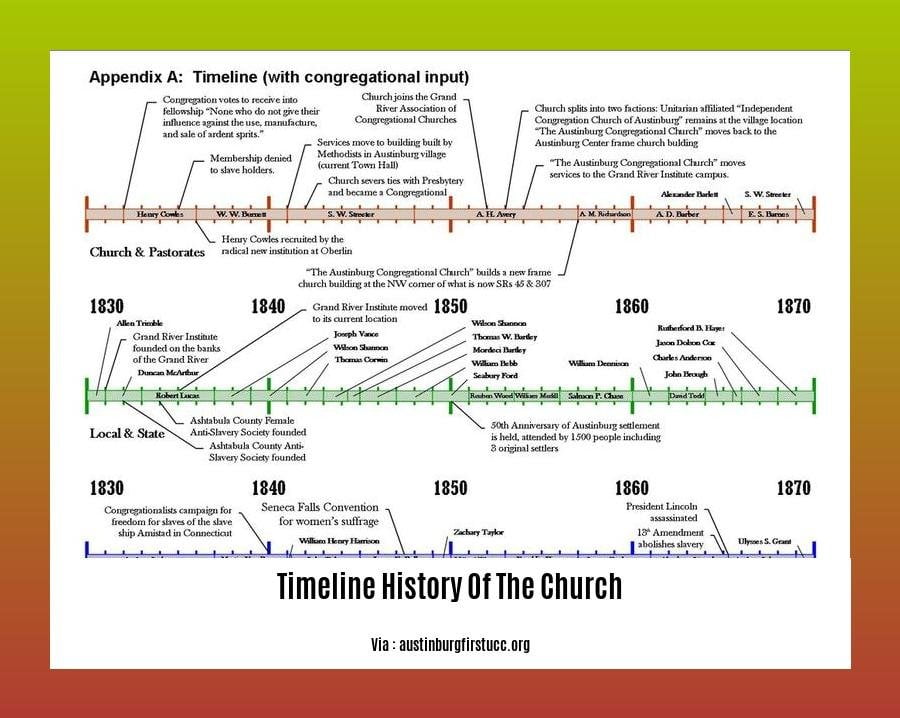

![A Historical Overview of the Church: Tracing Its Evolution Through the Ages [History of the Church Summary] history-of-the-church-summary_2](https://www.lolaapp.com/wp-content/uploads/2023/12/history-of-the-church-summary_2-150x150.jpg)



